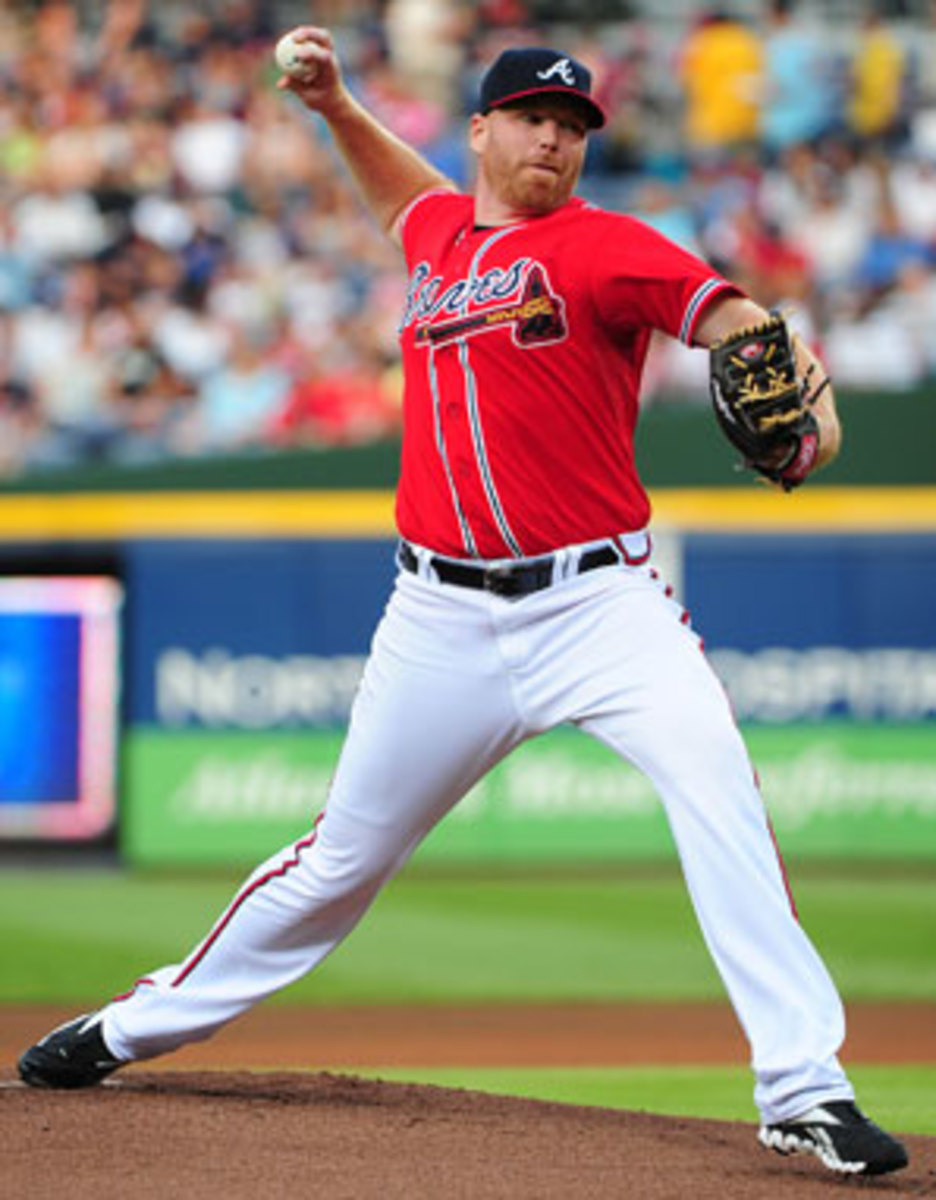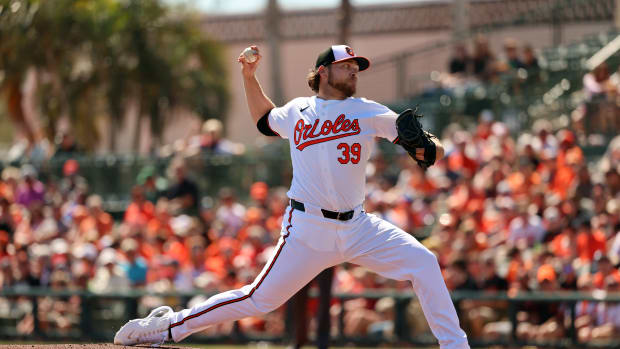Braves' trade of Hanson suggests deeper concerns about his future
Tommy Hanson's declining fastball velocity and injury history may have been red flags for Atlanta. (Scott Cunningham/Getty Images)
Back in 2009, the Braves' Tommy Hanson was one of the most heralded young prospects in the game, a 22-year-old 6-foot-6 righty whom Baseball America ranked number four on its Top 100 Prospects list after an outstanding 2008 season split between High-A and Double-A. By the first week of June, he was in the majors, kicking off an abbreviated rookie season in which he would post a 2.89 ERA and strike out 8.3 per nine in 21 starts — a stellar debut. That same year, the Angels' Jordan Walden, a 21-year-old 6-foot-5 righty, ranked 70th on Baseball America's list after a good '08 season spent at two A-ball levels. Walden didn't debut until the majors until late August of 2010, by which point he had fallen off BA's prospect list and moved to the bullpen.
On Friday, the Braves and Angels swapped the two pitchers in a straight-up deal, one that at first appears to be a mismatch — a steal for the Angels given Hanson's low price tag as a first-year arbitration-eligible player, and a miscalculation for the Braves given the unlikelihood of a late-inning setup man delivering value on par with a mid-rotation starter. A closer look suggests that the Braves must have significant fears regarding Hanson's future after a subpar season and an ominous trend in declining velocity. This trade is a reminder that the Hot Stove scene is driven by information asymmetry — teams know far more, good and bad, about the players they control, and what can appear to be head-scratching decisions from the outside may have sound reasons that are unstated, or understated.
We've seen that a whole lot in the past week, with the Rays and Mets choosing to spend big to retain Evan Longoria and David Wright into the next decade rather than set aside that money to woo free agents or retain younger players. Meanwhile, the Rangers appear bent on letting Josh Hamilton depart given his stormy past, and the Yankees decided that what they knew about Russell Martin wasn't enough for them to want to keep him.
Which isn't to say that the Angels are receiving damaged goods in Hanson, but the gamble on Atlanta's part is that he isn't the same pitcher he was two or three years ago, the one who appeared bound to become a true ace or at least a front-of-the-rotation starter. In four big league seasons, he has reached the 180-inning level just once, that back in 2010 at the age of 23, when he threw 202 2/3 innings of 3.33 ERA ball. By today's standards, that's a heavy workload for a young pitcher, and it may have contributed to the two months Hanson spent on the disabled list in 2011 due to a rotator cuff strain and tendonitis in his shoulder. He threw just 130 innings that year, and while his strikeout rate climbed to 9.8 per nine, his walk and home run rates increased as well, as did his ERA. He was back up to 174 2/3 innings last year, but his performance was much worse:
Year | IP | HR/9 | BB/9 | SO/9 | ERA | FIP |
2009 | 127.2 | 0.7 | 3.2 | 8.2 | 2.89 | 3.46 |
2010 | 202.2 | 0.6 | 2.5 | 7.7 | 3.33 | 3.33 |
2011 | 130.0 | 1.2 | 3.2 | 9.8 | 3.60 | 3.64 |
2012 | 174.2 | 1.4 | 3.7 | 8.3 | 4.48 | 4.61 |
Hanson's home run and walk rates both ballooned, and his strikeout rate, while still high, came back to earth. He also spent 17 days on the DL with a lower back strain, and was less effective after returning (4.99 ERA over 48 2/3 innings) in mid-August.
Hanson's ERAs have increased in every season since his rookie year, and they've been almost perfectly aligned with estimates based on his peripherals via the Fielding Independent Pitching stat. Meanwhile, his average fastball velocity has been moving in the wrong direction. According to the park-adjusted data at BrooksBaseball.net (much preferable to the raw data found elsewhere), he's gone from an average of 92.9 mph as a rookie to 93.5 mph the following year to 91.9 in 2011 and then just 90.4 in 2012 — a loss of three miles an hour in two years. He's still got a strong strikeout rate, in part because his reliance on a very good slider has increased from 24 percent as a rookie to 30 percent last year, the ninth-highest rate among starters. All of this suggests a fair amount of wear and tear on the arm of a 26-year-old pitcher, and perhaps not the bright future that was anticipated for him.
Getting back to the workload issue, since teams became increasingly conscious of pitch counts and workloads over the past decade, they've begun to shy away from piling 200-innings upon the shoulders of younger pitchers. From 2003 through 2012, just 15 pitchers age 23 and younger have reached the 200-inning level including Hanson, five of them twice. That's down from 24 pitchers in the 1993-2002 period, two of them twice. Of those recent 200-inning seasons, 21 of them featured ERAs better than the park-adjusted league average, which is to say ERA+ marks higher than 100; the other two were at 100 and 96. That makes sense, as there was no point in teams riding the arms of young pitchers who were below average. Of those 15 heavily-used young pitchers from the past decade, just six have an ERA+ above 100 since that big season, with one more right at 100:
Player | IP | Year | Age | Tm | ERA | ERA+ | Post-IP | ERA | ERA+ |
437.2 | 2010-2011 | 22-23 | LAD | 2.58 | 146 | 227.2 | 2.53 | 150 | |
442.3 | 2008-2009 | 22-23 | SEA | 2.69 | 152 | 715.1 | 2.92 | 131 | |
438.4 | 2007-2008 | 22-23 | SFG | 2.93 | 145 | 882.0 | 2.93 | 129 | |
Carlos Zambrano | 400.2 | 2003-2004 | 22-23 | CHC | 3.55 | 123 | 1419.1 | 3.82 | 115 |
207.2 | 2011 | 23 | OAK | 4.16 | 96 | 200.0 | 3.78 | 110 | |
Mark Prior | 211.1 | 2003 | 22 | CHC | 2.43 | 179 | 210.1 | 4.41 | 101 |
Chad Billingsley | 200.2 | 2008 | 23 | LAD | 3.14 | 133 | 725.2 | 3.86 | 100 |
Tommy Hanson | 202.2 | 2010 | 23 | ATL | 3.33 | 117 | 304.2 | 4.11 | 96 |
204.0 | 2006 | 23 | LAA | 4.28 | 106 | 1138.0 | 4.30 | 96 | |
Jair Jurrjens | 215.0 | 2009 | 23 | ATL | 2.60 | 159 | 316.2 | 4.18 | 93 |
206.2 | 2007 | 23 | TBD | 3.48 | 130 | 451.1 | 4.85 | 88 | |
Dontrelle Willis | 236.1 | 2005 | 23 | FLA | 2.63 | 152 | 627.2 | 5.02 | 86 |
215.1 | 2006 | 23 | PIT | 4.47 | 100 | 754.2 | 4.84 | 86 | |
Jeremy Bonderman | 214.0 | 2006 | 23 | DET | 4.08 | 111 | 427.0 | 5.19 | 85 |
That's a list full of woe. While Kershaw, Hernandez and Cain have remained elite pitchers, and Zambrano proved exceptionally durable for a long time before falling off, Prior, Kazmir, Willis and Bonderman all met premature demises as major league hurlers, while Billingsley, Santana, Jurrjens and Duke haven't come close to being able to live up to their early performances. The jury is still out on Cahill and Hanson, as well as Madison Bumgarner, who has two 200-inning seasons under his belt and who is only just entering his age-23 season.
Particularly given that Hanson is only going to make a few million dollars in 2013 as a first-time arbitration eligible player, the Braves must not think very highly of his future, because otherwise a 26-year-old starting pitcher with career marks of a 3.61 ERA and 8.4 strikeouts per nine with three years of club control ahead of him is the kind of player who should be able to net a huge haul via trade. He should certainly be able to net more than one reliever, even a late-game flamethrower such as Walden with a career ERA of 3.06, 10.8 strikeouts per nine and another year before he reaches arbitration eligibility. It's tough not to conclude that the Braves — who know his medical history, his work habits and his relationship with his teammates and coaches better than the other 29 teams do — thought they had a ticking timebomb on their hands, a pitcher likely to break down with increasing frequency as he grew more expensive.
Maybe that's the case, even if Hanson passes his physical to complete the deal. He may well be the next Kazmir, the cautionary tale whom the Angels acquired from the Rays for a trio of prospects — future starting shortstop Sean Rodriguez among them — midway through his age-25 season in 2009. Following a six-start, 1.93 ERA performance for the Angels after being acquired, he was rocked for a 5.94 ERA in 150 innings the next year while missing time due to shoulder woes, and made just one big league appearance after that before being released in June 2011, a $20 million failure on Anaheim's watch.
Fortunately for the Angels, Hanson doesn't carry that kind of financial risk. He's part of an effort to save money as the team fills out its rotation beyond Jered Weaver and C.J. Wilson; Los Angeles already declined a $15.5 million option on Dan Haren, and managed to unload $12 million of Santana's $13 million 2013 salary on the Royals. That cost-cutting was supposed to help the Halos retain free agent Zack Greinke, whom they traded for back in July, but the Angels are increasingly concerned about their ability to woo him away from the even freer-spending Dodgers. Add Hanson to a unit that will be rounded out by Garret Richards and will likely also include at least one more pricey pitcher if they don't land Greinke, and they can cross their fingers and hope for the best.
Having signed closer Ryan Madson to a one-year, $6 million deal earlier this week, the Angels can bump Ernesto Frieri back into a setup role without missing Walden, who took over closer duties and saved 32 games as a rookie in 2011 but lost the job early last year and spent six weeks on the DL due to a biceps strain. The 60 innings that he might provide should have a whole lot less value than the 170 to 200 that Hanson might give them if things go well.
With Hanson gone, the Braves' rotation now shapes up as Tim Hudson, Kris Medlen, Mike Minor, Paul Maholm and Randall Delgado, with Julio Teheran waiting in the wings and Brandon Beachy potentially returning from Tommy John surgery later in the year. It's a group with plenty of upside, but also a whole lot of inexperience. Hudson and Maholm are the only hurlers with more than one full season in a rotation under their belts and Minor's 2012 is the only other 30-start season from the rest of the group. Walden instantly becomes the top righty setup man in front of Craig Kimbrel, joining lefties Jonny Venters and Eric O'Flaherty as part of a dominant late-game unit.




































